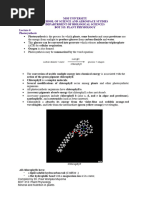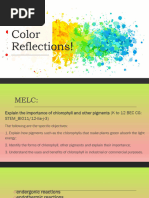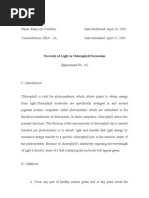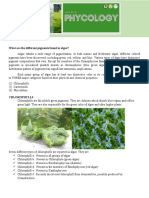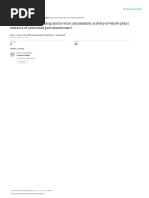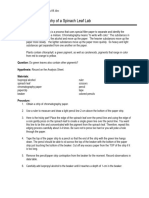0 ratings0% found this document useful (0 votes)
38 viewsPlant Pigments 2024
Plant Pigments 2024
Uploaded by
Paramveer SinghPlant Physiology - Plant Pigments.
Copyright:
© All Rights Reserved
Available Formats
Download as PDF, TXT or read online from Scribd
Plant Pigments 2024
Plant Pigments 2024
Uploaded by
Paramveer Singh0 ratings0% found this document useful (0 votes)
38 views19 pagesPlant Physiology - Plant Pigments.
Copyright
© © All Rights Reserved
Available Formats
PDF, TXT or read online from Scribd
Share this document
Did you find this document useful?
Is this content inappropriate?
Plant Physiology - Plant Pigments.
Copyright:
© All Rights Reserved
Available Formats
Download as PDF, TXT or read online from Scribd
Download as pdf or txt
0 ratings0% found this document useful (0 votes)
38 views19 pagesPlant Pigments 2024
Plant Pigments 2024
Uploaded by
Paramveer SinghPlant Physiology - Plant Pigments.
Copyright:
© All Rights Reserved
Available Formats
Download as PDF, TXT or read online from Scribd
Download as pdf or txt
You are on page 1of 19
PLANT PIGMENTS
STRUCTURE AND THEIR ROLE
DR. SHARADA POTUKUCHI, SCHOOL OF BIOTECHNOLOGY, SMVDU, KATRA, J&K
Introduction: What Are Pigments ?
Pigments are “molecules that absorb
specific wavelength (energies) of light
and reflect all others.”
Pigments are coloured compounds.
The colour we see is the net effect of all
the light reflecting back at us…!
They are the substances produced by
living organisms that have a colour
resulting from selective colour absorption.
DR. SHARADA POTUKUCHI, SCHOOL OF BIOTECHNOLOGY, SMVDU, KATRA, J&K
PRIMARY FUNCTION OF PIGMENTS IN
PLANTS
Primary Function : Photosynthesis
Uses green pigment chlorophyll along with
several red and yellow pigments.
Help to capture as much light as possible.
Other functions include attracting insects to
flowers for encouraging pollination.
DR. SHARADA POTUKUCHI, SCHOOL OF BIOTECHNOLOGY, SMVDU, KATRA, J&K
Pigments in Plants-:
The Principal pigments in plants are-:
1. Chlorophyll
2. Carotenoids
3. Xanthophylls
4. Anthocyanins
5. Betalins
6. Phycobilins
DR. SHARADA POTUKUCHI, SCHOOL OF BIOTECHNOLOGY, SMVDU, KATRA, J&K
CHLOROPHYLL
Primary pigment in plant.
Chlorin absorbs yellow and blue wavelengths.
Reflecting green.
All land plants and green algae have two types
of chlorophyll: Chlorophyll a and Chlorophyll b.
Kelps (protists) and photosynthetic heterokonts
contain Chlorophyll c.
Chlorophyll serve as fuel to photosynthesis.
DR. SHARADA POTUKUCHI, SCHOOL OF BIOTECHNOLOGY, SMVDU, KATRA, J&K
CHLOROPHYLL
Name derived from greek words
Chloros means “green” and phyllon means
“leaf”.
Synthesized from succinyl-CoA and Glycine.
Immediate precursor to Chlorophyll A and B is
protochlorophyllide.
Contains hydrophobic phytol chain embedded in
lipid membrane.
Rest structure is tetrapyrrolic ring.
It is the part of pigment that absorbs the energy
from light.
DR. SHARADA POTUKUCHI, SCHOOL OF BIOTECHNOLOGY, SMVDU, KATRA, J&K
Structure of Chlorophyll
DR. SHARADA POTUKUCHI, SCHOOL OF BIOTECHNOLOGY, SMVDU, KATRA, J&K
STRUCTURE OF Chlorophyll a & Chlorophyll b
DR. SHARADA POTUKUCHI, SCHOOL OF BIOTECHNOLOGY, SMVDU, KATRA, J&K
AccessoryPigments
Role of AccessoryPigments:
Accessorypigmentshelp plantsabsorb
additional light. Plants need to make
these accessory pigments to maximize
theamountofphotosynthesisthey can
do.
Morepigments= Moreglucoseorfood
for theplant!
DR. SHARADA POTUKUCHI, SCHOOL OF BIOTECHNOLOGY, SMVDU, KATRA, J&K
Types of Accessory
Pigments
Carotenoids:reflect yellow, orange,andredlight.
Anthocyans:reflect red,blue,violetlight.
Xanthophylls: reflect yellowlight.
Phycobilins:reflect red and yellowlight
DR. SHARADA POTUKUCHI, SCHOOL OF BIOTECHNOLOGY, SMVDU, KATRA, J&K
CAROTENOIDS
Carotenoids are organic pigments that are found in
chloroplasts and chromoplasts of plants and other
photosynthetic oranisms.
Function as accessory pigments in plants.
Absorb wavelength not readily absorbed by chlorophyll.
Eg: Carotene (Found in Carrots)
Lutein (Yellow pigment found in fruits and vegetables).
Lycopene (Red pigment in tomatoes)
Attract pollinators and seed dispersers
Accessory photosynthetic Pigment in periods of low light
Anti-oxidant roles
Substrates for hormones
DR. SHARADA POTUKUCHI, SCHOOL OF BIOTECHNOLOGY, SMVDU, KATRA, J&K
Structure of Carotenoids
Lycopene
DR. SHARADA POTUKUCHI, SCHOOL OF BIOTECHNOLOGY, SMVDU, KATRA, J&K
ANTHOCYANINS
Literally “Flower blue”
Belong to Water soluble flavanoid pigments
Have purple colour and are present in vegetables (onions,
cabbage, potatoes), red, blue & purple berries, black
beans
Attract pollinators and seed dispersers, repel predators,
protect cells from damage by excess light,
Improve plant tolerance to stress such as drought, U V-B
Improve night vision and other vision disorders, protect
against heart disease.
Examples: Cyanidin, Aurantinidin, Malvidin
DR. SHARADA POTUKUCHI, SCHOOL OF BIOTECHNOLOGY, SMVDU, KATRA, J&K
Structure of Anthocyanin
DR. SHARADA POTUKUCHI, SCHOOL OF BIOTECHNOLOGY, SMVDU, KATRA, J&K
XANTHOPHYLL
Typical yellow pigments of leaves.
Essentially oxidized carotenes synthesized within plastids.
Xanthophylls do not require light for synthesis, so that
xanthophylls are present in all young leaves as well as in
etiolated leaves.
Xanthophylls in leaves have an important function
as accessory pigments, capturing certain wavelengths of
sunlight not absorbed by chlorophylls, and thereby increasing
overall absorptance of the visible spectrum of sunlight.
Group of xanthophylls includes lutein, zeaxanthin,
neoxanthin.
Examples of other rich sources include papaya, peaches,
prunes, and squash, which contain lutein diesters.
DR. SHARADA POTUKUCHI, SCHOOL OF BIOTECHNOLOGY, SMVDU, KATRA, J&K
STRUCTURE OF XANTHOPHYLL
XANTHOPHYLL
DR. SHARADA POTUKUCHI, SCHOOL OF BIOTECHNOLOGY, SMVDU, KATRA, J&K
PHYCOBILINS
Phycobilins are water-soluble pigments found in the stroma of
chloroplast organelles that are present only in Cyanobacteria and
Rhodophyta.
The two classes of phycobilins include phycocyanin and
phycoerythrin.
Phycocyanin is a bluish pigment found in primarily cyanobacteria
(blue-green algae) to aid in absorption of light in
photosynthesis.
Phycoerythrin is a pigment found in Rhodopyta (red algae) that is
responsible for its characteristic red color. It is an accessory
pigment that allows red algae to carry out photosynthesis in
deep water where wavelengths of blue light are most abundant
by absorbing blue light and reflecting red light.
DR. SHARADA POTUKUCHI, SCHOOL OF BIOTECHNOLOGY, SMVDU, KATRA, J&K
STRUCTURE OF PHYCOBILINS
Phycoerythrin
DR. SHARADA POTUKUCHI, SCHOOL OF BIOTECHNOLOGY, SMVDU, KATRA, J&K
Conclusion
Plant pigments assist in absorption of light during
photosynthesis.
They tap sources of light energy which would otherwise be
unused by plant, if it relied only on chlorophyll.
They give a unique color to plants.
Attract pollinators, seed dispersals and repel predators.
Improve plant tolerance against drought, UV light etc.
Acts as an antioxidant.
Add up to plant biomass.
DR. SHARADA POTUKUCHI, SCHOOL OF BIOTECHNOLOGY, SMVDU, KATRA, J&K
You might also like
- Reading Explorer 1 Third Edition Paul Macintyre David Bohlke 14 20Document7 pagesReading Explorer 1 Third Edition Paul Macintyre David Bohlke 14 20Hồ Hoàng Tín100% (2)
- Biology ReviewerDocument5 pagesBiology ReviewerDustin SapioNo ratings yet
- Chloroplast and ChlorophyllDocument11 pagesChloroplast and ChlorophyllMarion Tan CuecoNo ratings yet
- Jinky Oraiz@deped Gov PHDocument10 pagesJinky Oraiz@deped Gov PHRemuel VillanuevaNo ratings yet
- Chlorophyl lDocument35 pagesChlorophyl ludontknowme560No ratings yet
- Lecture 6 PhotosynthesisDocument12 pagesLecture 6 Photosynthesismichael328wanjiruNo ratings yet
- WEEK 2 Color ReflectionsDocument31 pagesWEEK 2 Color Reflectionsjhon achilles dugoNo ratings yet
- Importance of Chlorophyll and Other PigmentsDocument35 pagesImportance of Chlorophyll and Other PigmentsEriNo ratings yet
- Chlorophyll and Other PigmentsDocument16 pagesChlorophyll and Other PigmentsMarie Ann Diane EmanoNo ratings yet
- Photosynthetic PigmentsDocument4 pagesPhotosynthetic PigmentsShwe Pwint Pyae Sone100% (2)
- General Biology 1 (Chloroplast, Chlorophyll and Pigment)Document6 pagesGeneral Biology 1 (Chloroplast, Chlorophyll and Pigment)Jean DaclesNo ratings yet
- Chlorophylls and Other PigmentsDocument6 pagesChlorophylls and Other PigmentsHope Ladyline EspanolaNo ratings yet
- Kumare 1Document12 pagesKumare 1api-3765516No ratings yet
- Assignment 3Document4 pagesAssignment 3Zephaniah SomeraNo ratings yet
- Topic 2. Chlorophyll and Other PigmentsDocument7 pagesTopic 2. Chlorophyll and Other Pigmentslongvineaircon48No ratings yet
- Elicit: Pre-TestDocument4 pagesElicit: Pre-TestVibar, Danica V.No ratings yet
- Photosynthesis and The Role of PigmentsDocument3 pagesPhotosynthesis and The Role of PigmentsJiex CabalunaNo ratings yet
- Researched InformationDocument1 pageResearched InformationCris D. MaureNo ratings yet
- Color ReflectionsDocument14 pagesColor ReflectionsIan Joshua SanchezNo ratings yet
- Biology - XI - Photosynthesis in Higher Plants - IntroductionDocument47 pagesBiology - XI - Photosynthesis in Higher Plants - IntroductionSDO BSNL NALAGARHNo ratings yet
- Phytosynthesis: Pharmaceutical Botany With TaxonomyDocument2 pagesPhytosynthesis: Pharmaceutical Botany With TaxonomyVanessa RamosNo ratings yet
- PigmentDocument11 pagesPigmentJai Balaji BakerNo ratings yet
- photosynthetic pigements researchDocument2 pagesphotosynthetic pigements researchMariam SaeedNo ratings yet
- Pigments Found in Vegetables and Its Extraction TechniqueDocument14 pagesPigments Found in Vegetables and Its Extraction TechniquejanhavinakhareNo ratings yet
- PhotosynthesisDocument63 pagesPhotosynthesisselesmabNo ratings yet
- Gyaaba Joanita Aba Maame_8367421_report 5Document8 pagesGyaaba Joanita Aba Maame_8367421_report 5Aba JoanitaNo ratings yet
- كتاب الاحياء - خامس علمي متميزينDocument128 pagesكتاب الاحياء - خامس علمي متميزينimohammedwalaa23No ratings yet
- 2nd Chlorophyll NotesDocument22 pages2nd Chlorophyll NotesfbatohinogNo ratings yet
- 4 pig phto&respiration1 new2024(Autosaved)Document83 pages4 pig phto&respiration1 new2024(Autosaved)Kholud HemeedaNo ratings yet
- Botany - AssignmentDocument2 pagesBotany - AssignmentLeah Hope CedroNo ratings yet
- 4 Pig Phto&Respiration1 New2024(Autosaved)Document85 pages4 Pig Phto&Respiration1 New2024(Autosaved)Kholud HemeedaNo ratings yet
- q2 l2 General Biology 1 The Importance of Chlorophyll and Other Pigments CompressedDocument20 pagesq2 l2 General Biology 1 The Importance of Chlorophyll and Other Pigments CompressedKittine FormilosNo ratings yet
- Chlorophyll and Other PigmentsDocument19 pagesChlorophyll and Other PigmentsMeghan Old75% (4)
- BiologyDocument21 pagesBiologyHrituraj banikNo ratings yet
- Nishant Mishra: Dav Public School Kalinga NagarDocument24 pagesNishant Mishra: Dav Public School Kalinga NagarNishant MishraNo ratings yet
- Ivestigatory Project On Biology 12Document24 pagesIvestigatory Project On Biology 12Nishant MishraNo ratings yet
- CarotenoidsDocument11 pagesCarotenoidsMarvin JeaNo ratings yet
- 01 Carotenoid Biosynthesis in ArabidopsisDocument28 pages01 Carotenoid Biosynthesis in ArabidopsisSaraNo ratings yet
- Chlorophyll & Other PigmentsDocument37 pagesChlorophyll & Other PigmentsJanine CambaNo ratings yet
- What Are CarotenoidsDocument18 pagesWhat Are CarotenoidsChandra ReddyNo ratings yet
- Chlorophyll and Other Pigment (Final Presentation) pt.2Document29 pagesChlorophyll and Other Pigment (Final Presentation) pt.2Lloyd Gabriel PoligratesNo ratings yet
- Biology Project 1Document23 pagesBiology Project 1Aashray KothaNo ratings yet
- Biology Investigatory ProjectDocument18 pagesBiology Investigatory ProjectSekhar Sahoo100% (5)
- Amount of Chlorophyll in Five LeafDocument24 pagesAmount of Chlorophyll in Five LeafRakshitha MgowdaNo ratings yet
- Chlorophyl LDocument2 pagesChlorophyl LDk MobilelegendNo ratings yet
- Plant Physiology - WikipediaDocument16 pagesPlant Physiology - Wikipediavsagri01No ratings yet
- Phytoconstituents, Pigments, Gas Chromatography Mass SpectrometryDocument7 pagesPhytoconstituents, Pigments, Gas Chromatography Mass Spectrometryshrk25evNo ratings yet
- General Biology2Document8 pagesGeneral Biology2shanepixy04No ratings yet
- Lak Singh Solution For Class 10 Bio Chapter 1 Life ProcessDocument89 pagesLak Singh Solution For Class 10 Bio Chapter 1 Life ProcessZenitsu FFNo ratings yet
- Phytochemical Screening and in Vitro Antioxidant ADocument7 pagesPhytochemical Screening and in Vitro Antioxidant ANazir BsahaNo ratings yet
- Life Processes Ppt1 - CopyDocument49 pagesLife Processes Ppt1 - Copyrushathk99No ratings yet
- The Importance of Chlorophyll q2Document32 pagesThe Importance of Chlorophyll q2gwynettedalupire803No ratings yet
- An Introduction To The Chemistry of Dietary CarotenoidsDocument19 pagesAn Introduction To The Chemistry of Dietary CarotenoidsChandra ReddyNo ratings yet
- Annurev 2earplant 2E59 2E032607 2E092859Document31 pagesAnnurev 2earplant 2E59 2E032607 2E092859andiNo ratings yet
- Vol4 SPL (1) P 38-51Document14 pagesVol4 SPL (1) P 38-51Edris AslamiNo ratings yet
- FILE - 20210529 - 153336 - Naturally Occurring Anthocyanin Structure Functions and Biosyntheticpathway in Fruit Plants 2329 9029 1000187Document9 pagesFILE - 20210529 - 153336 - Naturally Occurring Anthocyanin Structure Functions and Biosyntheticpathway in Fruit Plants 2329 9029 1000187Nguyen Thi Thuy Duong B1606703No ratings yet
- Carotenoids in FlowersDocument61 pagesCarotenoids in FlowersSuhrita Chakrabarty100% (1)
- 1651135668class 7 (Science Notes Ch-1 Nutritio in Plants)Document3 pages1651135668class 7 (Science Notes Ch-1 Nutritio in Plants)VijayaLakshmi KuchimanchiNo ratings yet
- Biology Investigatory ProjectDocument18 pagesBiology Investigatory ProjectSekhar SahooNo ratings yet
- WH at Ex Ac Tly Is Visi Ble Light?Document8 pagesWH at Ex Ac Tly Is Visi Ble Light?AbhishekkpNo ratings yet
- Idhant Doneria - Absorption of Photosynthetic Pigments in Plants. - WorksheetDocument3 pagesIdhant Doneria - Absorption of Photosynthetic Pigments in Plants. - WorksheetIdhant DoneriaNo ratings yet
- Kami Export - Justin Noh - 2019.05 International Questions - PDF (NEW)Document55 pagesKami Export - Justin Noh - 2019.05 International Questions - PDF (NEW)thinman110707No ratings yet
- He Cookery GR10 Q2 Module1Document25 pagesHe Cookery GR10 Q2 Module1Sheen LibayNo ratings yet
- Algae - InformationDocument13 pagesAlgae - InformationPreNo ratings yet
- q2 m1 W1atp Adp Cycle ShsDocument26 pagesq2 m1 W1atp Adp Cycle ShsJem CorpuzNo ratings yet
- USABO Cell Biology Part 2Document28 pagesUSABO Cell Biology Part 2Emelyn PagsanjanNo ratings yet
- SUB159224Document5 pagesSUB159224Fitri SyamsiyahNo ratings yet
- Color ReflectionsDocument14 pagesColor ReflectionsIan Joshua SanchezNo ratings yet
- Advanced Chemistry Final Lab ReportDocument14 pagesAdvanced Chemistry Final Lab Reportapi-644259218No ratings yet
- Paper Chromatography (INK)Document4 pagesPaper Chromatography (INK)domingowinckhelNo ratings yet
- Lesson Plan in TleDocument6 pagesLesson Plan in TleRaquel MaribaoNo ratings yet
- AP Biology Lab Four: Plant Pigments and PhotosynthesisDocument5 pagesAP Biology Lab Four: Plant Pigments and PhotosynthesisCoolAsianDude98% (44)
- Concept of Leaf ChromatographyDocument2 pagesConcept of Leaf ChromatographyvnnrbkahNo ratings yet
- Biology Project: Plants With Different Leaf ColorDocument15 pagesBiology Project: Plants With Different Leaf ColorVijayalakshmi BalasubramanianNo ratings yet
- The Basics of Iridology 3 - Markings by Francesco PuerariDocument303 pagesThe Basics of Iridology 3 - Markings by Francesco PuerariAmit KapoorNo ratings yet
- t-022-present-simple-progressiveDocument12 pagest-022-present-simple-progressivevietphuong280No ratings yet
- Chromatography+of+Spinach 08Document4 pagesChromatography+of+Spinach 082858keshvi8bNo ratings yet
- Natural Colorants From Plant Pigments and Their Encapsulation: An Emerging Window For The Food IndustryDocument12 pagesNatural Colorants From Plant Pigments and Their Encapsulation: An Emerging Window For The Food Industrynata.garcia.316No ratings yet
- Assignment 3Document4 pagesAssignment 3Zephaniah SomeraNo ratings yet
- General Characteristics of AlgaeDocument9 pagesGeneral Characteristics of Algaesheralam4346No ratings yet
- Photosynthesis CO AssimilationDocument30 pagesPhotosynthesis CO AssimilationUttam GurungNo ratings yet
- Cosmetics 10 00047Document17 pagesCosmetics 10 00047KV DeepikaNo ratings yet
- INSECT COLORATION Notes by Huzaifa ParkarDocument6 pagesINSECT COLORATION Notes by Huzaifa ParkarHuzaifa Parkar100% (1)
- Vegetation Analysis Using Remote SensingDocument58 pagesVegetation Analysis Using Remote SensingMarianNo ratings yet
- BIO CH09 Chapter LabDocument6 pagesBIO CH09 Chapter Labitaemin243No ratings yet
- Tle10 He Cookery q2 Mod1 Performmiseenplace v3 (70 Pages)Document75 pagesTle10 He Cookery q2 Mod1 Performmiseenplace v3 (70 Pages)Marilyn Lamigo BristolNo ratings yet
- General Biology 1. SIP LIFE. Exam Questions - WEEK 1 The Role of Plant Pigments in PhotosynthesisDocument3 pagesGeneral Biology 1. SIP LIFE. Exam Questions - WEEK 1 The Role of Plant Pigments in PhotosynthesisDenisse OrigNo ratings yet
- Topic 1. The Importance of Chlorophyll and Other PigmentsDocument6 pagesTopic 1. The Importance of Chlorophyll and Other PigmentsSheryl Lou AngelesNo ratings yet
- Flavor Components of VegetablesDocument42 pagesFlavor Components of VegetablesXz Lee MonseratNo ratings yet






